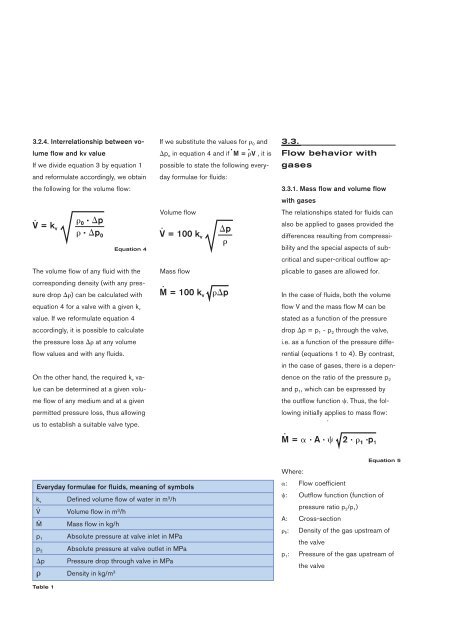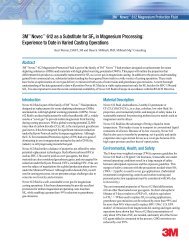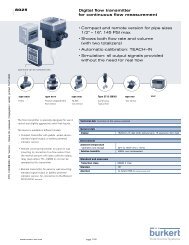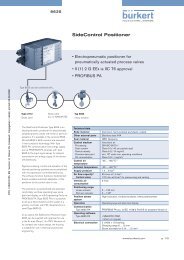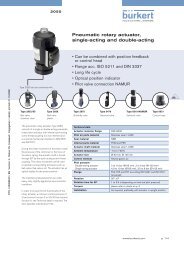Solenoid valves - Bürkert Fluid Control Systems
Solenoid valves - Bürkert Fluid Control Systems
Solenoid valves - Bürkert Fluid Control Systems
You also want an ePaper? Increase the reach of your titles
YUMPU automatically turns print PDFs into web optimized ePapers that Google loves.
3.2.4. Interrelationship between volume<br />
flow and kv value<br />
If we divide equation 3 by equation 1<br />
and reformulate accordingly, we obtain<br />
the following for the volume flow:<br />
· <br />
V = k 0 · p<br />
v<br />
· p 0<br />
The volume flow of any fluid with the<br />
corresponding density (with any pressure<br />
drop ) can be calculated with<br />
equation 4 for a valve with a given k v<br />
value. If we reformulate equation 4<br />
accordingly, it is possible to calculate<br />
the pressure loss at any volume<br />
flow values and with any fluids.<br />
If we substitute the values for 0 and<br />
· ·<br />
p o in equation 4 and if M = V , it is<br />
possible to state the following everyday<br />
formulae for fluids:<br />
Volume flow<br />
· p<br />
V = 100 k v<br />
<br />
Mass flow<br />
·<br />
M = 100 k v<br />
p<br />
On the other hand, the required k v value<br />
can be determined at a given volu-<br />
and p 1 , which can be expressed by<br />
dence on the ratio of the pressure p 2<br />
me flow of any medium and at a given<br />
the outflow function . Thus, the following<br />
initially applies to mass flow:<br />
permitted pressure loss, thus allowing<br />
·<br />
us to establish a suitable valve type.<br />
·<br />
M = · A · 2 · 1 ·p 1<br />
Where:<br />
: Flow coefficient<br />
Everyday formulae for fluids, meaning of symbols<br />
: Outflow function (function of<br />
k v Defined volume flow of water in m 3 /h<br />
·<br />
pressure ratio p<br />
V Volume flow in m 3 2 /p 1 )<br />
/h<br />
·<br />
A: Cross-section<br />
M Mass flow in kg/h<br />
1 : Density of the gas upstream of<br />
p 1 Absolute pressure at valve inlet in MPa<br />
the valve<br />
p 2 Absolute pressure at valve outlet in MPa<br />
p 1 : Pressure of the gas upstream of<br />
p Pressure drop through valve in MPa<br />
the valve<br />
Density in kg/m 3<br />
Table 1<br />
Equation 4<br />
3.3.<br />
Flow behavior with<br />
gases<br />
3.3.1. Mass flow and volume flow<br />
with gases<br />
The relationships stated for fluids can<br />
also be applied to gases provided the<br />
differences resulting from compressibility<br />
and the special aspects of subcritical<br />
and super-critical outflow applicable<br />
to gases are allowed for.<br />
In the case of fluids, both the volume<br />
flow V and the mass flow M can be<br />
stated as a function of the pressure<br />
drop p = p 1 - p 2 through the valve,<br />
i.e. as a function of the pressure differential<br />
(equations 1 to 4). By contrast,<br />
in the case of gases, there is a depen-<br />
Equation 5


